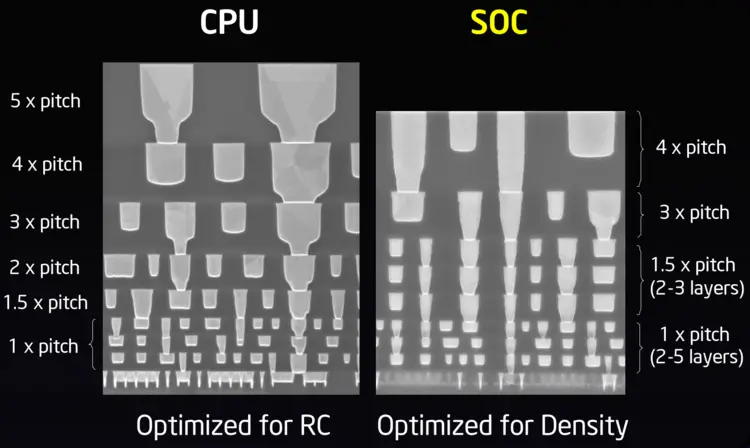From WikiChip
32 nm lithography process
The 32 nanometer (32 nm) lithography process is a full node semiconductor manufacturing process following the 40 nm process stopgap. Commercial integrated circuit manufacturing using 32 nm process began in 2010. This technology was superseded by the 28 nm process (HN) / 22 nm process (FN) in 2012.
Contents
Industry
TSMC cancelled its planned 32nm node process. Intel's 32 nm process became the first process to introduce the self-aligned via patterning.
| Process Name | |
|---|---|
| 1st Production | |
| Litho- graphy |
Lithography |
| Immersion | |
| Exposure | |
| Wafer | Type |
| Size | |
| Tran- sistor |
Type |
| Voltage | |
| Metal Layers | |
| Gate Length (Lg) | |
| Contacted Gate Pitch (CPP) | |
| Minimum Metal Pitch (MMP) | |
| SRAM bitcell |
High-Perf (HP) |
| High-Density (HD) | |
| Low-Voltage (LV) | |
| DRAM bitcell |
eDRAM |
| Intel | TSMC | Common Platform Alliance The Common Platform Alliance 20 nm node was a collaboration between IBM, Samsung, Freescale, Toshiba, Chartered Semiconductor Manufacturing, Infineon Technologies |
Toshiba / NEC | Common Platform Alliance (SOI) | |||||
|---|---|---|---|---|---|---|---|---|---|
| P1268 (CPU) / P1269 (SoC) | |||||||||
| 2009 | 2011 | ||||||||
| 193 nm | 193 nm | 193 nm | 193 nm | 193 nm | |||||
| Yes | Yes | Yes | Yes | Yes | |||||
| DP | DP | DP | DP | DP | |||||
| Bulk | Bulk | Bulk | Bulk | SOI | |||||
| 300 mm | 300 mm | 300 mm | 300 mm | 300 mm | |||||
| Planar | Planar | Planar | Planar | Planar | |||||
| 1 V, 0.75 V | 1.1 V | 1 V, 0.8 V | 1 V | 1 V | |||||
| 9 | 11 | 11 | |||||||
| Value | 45 nm Δ | Value | 40 nm Δ | Value | 45 nm Δ | Value | 40 nm Δ | Value | 45 nm Δ |
| 30 nm | 30 nm | 30 nm | 25 nm | ||||||
| 112.5 nm | 0.63x | 130 nm | 126 nm | 120 nm | 130 nm | ||||
| 112.5 nm | 0.70x | 100 nm | 100 nm | 100 nm | 100 nm | ||||
| 0.199 µm² | |||||||||
| 0.148 µm² | 0.15 µm² | 0.157 µm² | 0.124 µm² | 0.149 µm² | |||||
| 0.171 µm² | |||||||||
| 0.039 µm² | |||||||||
Design Rules
Find models
Click to browse all 32 nm MPU models
32 nm Microprocessors
- AMD
- Intel
- UC Davis
- Princeton
This list is incomplete; you can help by expanding it.
32 nm Microarchitectures
- AMD
- IBM
- Intel
This list is incomplete; you can help by expanding it.
Documents
References
- Greene, B., et al. "High performance 32nm SOI CMOS with high-k/metal gate and 0.149 µm 2 SRAM and ultra low-k back end with eleven levels of copper." VLSI Technology, 2009 Symposium on. IEEE, 2009.
- Jan, C-H., et al. "A 32nm SoC platform technology with 2 nd generation high-k/metal gate transistors optimized for ultra low power, high performance, and high density product applications." Electron Devices Meeting (IEDM), 2009 IEEE International. IEEE, 2009.
- Wu, Shien-Yang, et al. "A 32nm CMOS low power SoC platform technology for foundry applications with functional high density SRAM." Electron Devices Meeting, 2007. IEDM 2007. IEEE International. IEEE, 2007.
- Chen, X., et al. "A cost effective 32nm high-K/metal gate CMOS technology for low power applications with single-metal/gate-first process." VLSI Technology, 2008 Symposium on. IEEE, 2008.
- Diaz, C. H., et al. "32nm gate-first high-k/metal-gate technology for high performance low power applications." Electron Devices Meeting, 2008. IEDM 2008. IEEE International. IEEE, 2008.
- Natarajan, S., et al. "A 32nm logic technology featuring 2 nd-generation high-k+ metal-gate transistors, enhanced channel strain and 0.171 μm 2 SRAM cell size in a 291Mb array." Electron Devices Meeting, 2008. IEDM 2008. IEEE International. IEEE, 2008.
- Hasegawa, S., et al. "A cost-conscious 32nm CMOS platform technology with advanced single exposure lithography and gate-first metal gate/high-k process." Electron Devices Meeting, 2008. IEDM 2008. IEEE International. IEEE, 2008.
- Arnaud, F., et al. "32nm general purpose bulk CMOS technology for high performance applications at low voltage." Electron Devices Meeting, 2008. IEDM 2008. IEEE International. IEEE, 2008.
- Pilo, Harold, et al. "A 64 Mb SRAM in 32 nm high-k metal-gate SOI technology with 0.7 V operation enabled by stability, write-ability and read-ability enhancements." IEEE Journal of Solid-State Circuits 47.1 (2012): 97-106.
 Semiconductor lithography processes technology
Semiconductor lithography processes technology
